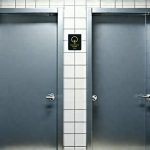Many people experience some level of discomfort when using public restrooms – concerns about cleanliness are common, as is a general sense of vulnerability. However, for a significant number of individuals, this discomfort escalates into a debilitating fear that actively impacts their daily lives. This fear isn’t merely about germs or hygiene; it’s often rooted in complex psychological factors and can lead to significant delays in essential bodily functions, impacting social activities, work productivity, and overall well-being. The anxiety associated with public toilet use can range from mild apprehension to full-blown panic attacks, creating a cycle of avoidance and distress that requires understanding and potential intervention.
This phenomenon isn’t widely discussed, contributing to feelings of shame and isolation for those who experience it. Individuals may develop elaborate coping mechanisms – restricting fluid intake, meticulously planning routes based on restroom availability (or avoiding situations altogether), or enduring significant physical discomfort rather than risking a public toilet encounter. These strategies, while seemingly effective in the short term, ultimately reinforce the fear and limit an individual’s freedom. Understanding the underlying causes and available support is crucial to breaking this cycle and regaining control over one’s life. This article will explore the complexities of bathroom delays stemming from the fear of using public toilets, offering insights into its origins, impacts, and potential coping strategies.
The Roots of Paruresis & Related Anxiety
The primary diagnosis often associated with the extreme fear of using public restrooms is paruresis, also known as “shy bladder syndrome.” However, it’s important to recognize that this fear rarely exists in isolation. It frequently co-occurs with other anxiety disorders and psychological factors. Paruresis isn’t necessarily about a physical inability to urinate; it’s the fear of being unable to do so when others are present or potentially observing. This fear creates a self-fulfilling prophecy: the anxiety itself inhibits urination, reinforcing the belief that one cannot go in public settings.
Beyond paruresis, several contributing factors can exacerbate this anxiety. These include:
– Social Anxiety Disorder: A persistent fear of being judged negatively by others.
– Generalized Anxiety Disorder: Excessive worry about a variety of things, including everyday situations like using a restroom.
– Obsessive-Compulsive Disorder (OCD): Though not always present, some individuals with this fear may experience obsessive thoughts related to cleanliness or contamination.
– Past Traumatic Experiences: Negative experiences in public restrooms – such as bullying, embarrassing accidents, or witnessing unpleasant events – can create lasting associations and trigger anxiety.
– Low Self-Esteem: Feelings of inadequacy or self-consciousness can amplify the fear of being judged.
The development of this type of anxiety is often a gradual process. It may begin with a single uncomfortable experience that triggers initial apprehension. Over time, as the individual avoids public restrooms to avoid discomfort, the fear intensifies and becomes more ingrained. The avoidance itself reinforces the anxiety, creating a vicious cycle. It’s crucial to understand that this isn’t a character flaw or a sign of weakness; it’s a treatable condition influenced by a complex interplay of psychological factors. If anxiety stems from issues around using facilities in public, understanding bathroom disruption can be helpful.
Impact on Daily Life & Well-being
The consequences of chronic fear surrounding public toilet use extend far beyond mere inconvenience. It can significantly disrupt various aspects of daily life, leading to social isolation, reduced quality of life, and even physical health problems. The constant worry about restroom access becomes all-consuming, impacting decision-making and limiting spontaneous activities. Individuals may:
– Avoid social gatherings and events for fear of needing a restroom.
– Limit travel opportunities, particularly long journeys.
– Experience significant distress at work or school if adequate restroom facilities aren’t available or private.
– Restrict fluid intake to minimize the need to urinate, potentially leading to dehydration and related health issues.
The psychological toll can be equally substantial. The constant anxiety and avoidance behaviors contribute to feelings of shame, guilt, and powerlessness. Individuals may feel embarrassed about their condition and reluctant to seek help for fear of judgment or ridicule. This isolation further exacerbates the problem, creating a cycle of distress. Moreover, the chronic stress associated with this fear can negatively impact mental health, potentially leading to depression, panic attacks, and other anxiety disorders. The cumulative effect of these factors can be profoundly debilitating, affecting an individual’s ability to live a full and satisfying life. It’s essential for those struggling with this issue to recognize that they are not alone and that help is available. A related concern may involve bathroom delays due to anxieties around food.
Coping Strategies & Self-Help Techniques
While professional intervention is often recommended (and will be discussed further below), several self-help techniques can provide immediate relief and support the recovery process. These strategies focus on reducing anxiety, challenging negative thoughts, and gradually reintroducing exposure to public restroom situations.
- Relaxation Techniques: Practicing relaxation techniques such as deep breathing exercises, progressive muscle relaxation, or mindfulness meditation can help calm the nervous system and reduce overall anxiety levels. Regularly incorporating these techniques into daily routines can build resilience and make it easier to cope with stressful situations, including those involving public restrooms.
- Cognitive Restructuring: This involves identifying and challenging negative thought patterns associated with public toilet use. For example, if someone believes “I will definitely embarrass myself if I try to go in a public restroom,” they can challenge this thought by asking themselves: “Is there evidence for this belief? What are the chances of that actually happening? Is there another way to look at this situation?” Replacing negative thoughts with more realistic and balanced perspectives can significantly reduce anxiety.
- Graded Exposure Therapy (Self-Guided): This is a core component of treatment, but can be started cautiously on your own. It involves gradually exposing yourself to feared situations in a controlled manner. Start with less anxiety-provoking scenarios – such as visualizing using a public restroom or standing near one – and slowly progress to more challenging situations, like briefly entering a restroom without attempting to use it, then eventually attempting to urinate while minimizing distractions. This process should be done at your own pace and with self-compassion. Sometimes digestive upset can exacerbate anxieties around bathroom use, creating a feedback loop.
Seeking Professional Help & Treatment Options
For many individuals, self-help techniques are not enough to overcome the fear of public toilets. In these cases, seeking professional help is essential. A variety of therapeutic approaches can be effective in treating paruresis and related anxiety disorders.
- Cognitive Behavioral Therapy (CBT): CBT is considered the gold standard treatment for this condition. It helps individuals identify and modify negative thought patterns and behaviors associated with public toilet use. Therapists using CBT will often incorporate graded exposure therapy, guiding patients through a structured process of gradually confronting their fears in a safe and supportive environment.
- Exposure Therapy: As mentioned above, exposure therapy is a key component of CBT. It involves repeatedly exposing the individual to feared situations until their anxiety diminishes. This can be done in vivo (real-life situations) or through imaginal exposure (visualizing the feared situation).
- Medication: While medication isn’t typically the first line of treatment, anti-anxiety medications or antidepressants may be prescribed in some cases to help manage symptoms and reduce overall anxiety levels. This should always be done under the guidance of a qualified medical professional.
It’s important to find a therapist who has experience treating anxiety disorders and specifically understands paruresis. The International Paruresis Association (IPA) website (https://www.paruresis.org/) provides valuable resources, including a directory of therapists specializing in this condition. If anxieties around bathrooms are tied to fear of public spaces, consider exploring digestive slowdown.
Resources & Support Networks
Navigating the challenges associated with fear of public toilets can be significantly easier with access to support and information. Several organizations and online communities offer valuable resources for individuals struggling with paruresis and related anxieties. The IPA (https://www.paruresis.org/) is a leading resource, providing information about the condition, treatment options, and a global network of support groups. Online forums and communities allow individuals to connect with others who understand their experiences, share coping strategies, and offer encouragement. Remember that seeking help is a sign of strength, not weakness, and there are people who care and want to support you on your journey toward recovery. You deserve to live a life free from the limitations imposed by this fear. Furthermore, understanding how bathroom rhythm loss can develop is important for holistic wellness.


















